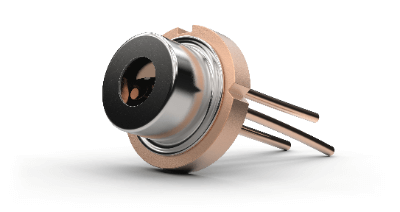What Is a Laser Diode?
 A laser diode is a device that uses a semiconductor mechanism known as recombination emission. The word “laser” is an acronym for “Light Amplification by the Stimulated Emission of Radiation”, where radiation is light.
A laser diode is a device that uses a semiconductor mechanism known as recombination emission. The word “laser” is an acronym for “Light Amplification by the Stimulated Emission of Radiation”, where radiation is light.
The color of the laser is determined by the elements that make up the semiconductor. Some lasers operate at room temperature, while others require cooling, depending on the resonator structure and output power.
The difference between laser diodes and LEDs is that laser diodes meet the requirements for laser oscillation. Variations in wavelength and amplitude of the light are much smaller in laser diodes as well.
Uses of Laser Diodes
Laser diodes (LDs) are widely used in consumer information equipment because of their small size, low power consumption, and low cost. They’re also lightweight, efficient, and highly reliable.
They are used in barcode readers, in optical pickups for optical drives such as CDs, DVDs, and BDs, copiers, laser printers, and optical fiber-based communication devices. High-power laser beams are also used in laser markers and laser processing machines.
The diffusion-resistant and long-distance reach of laser light makes them suitable for use in surveying instruments and laser pointers for pointing at objects. Because they emit coherent light, they are ideal for leveling and alignment applications.
Principles of Laser Diodes
In laser diodes, coherent light is emitted by the recombination of holes (“holes” here means spaces from which electrons have been released) and electrons when a voltage is applied.
The emitted photon causes another electron to recombine with the hole one after another, emitting photons, so that the generated light has the same phase and wavelength. Since the wavelength of the light is always constant, it is used in barcode readers, laser pointers, fiber-optic communications, and other applications requiring a constant amount of light.
Other Information on Laser Diodes
1. Laser Diode Specifications
The L/I curve is used to understand laser diodes specifications. This curve allows us to keep track of the drive current supplied by the light intensity output.
This curve is used to determine the operating point (drive current at rated emission output) and threshold current (starting current of laser oscillation) at the laser and is also used to determine the current required to obtain high output power at a particular current.
By reading this curve chart, one can see that optical output depends greatly on temperature, and that as temperature increases, laser parameters decrease. This makes it possible to visualize and estimate the efficiency of laser diodes by incorporating the L/I curve.
2. Laser Diodes Vs. Light-Emitting Diodes
While both are classed as electro-electronic components, light-emitting diodes (LEDs) have disparate phases, so light rays are diffused radially; in contrast, laser diodes are in phase with each other, resulting in a linear beam of light. The light emitted by a laser is also monochromatic, meaning it’s a bright, single-colored emission. Moreover, laser light is stimulated to emit coherently and efficiently, while light-emitting diodes utilize the electro-luminance effect, which is inferior.
Therefore, light-emitting diodes have an unfavorable characteristic in that their emitted light won’t easily enter a fiber with a small core system due to the wide surface of the light-emitting layer. On the other hand, laser diodes have a narrow emitting layer, making it easy for the light to enter a fiber with a small core system.
And since laser diodes emit photons by colliding every emitted photon with another atom, the light produced is coherent and the light beam is monochromatic. In contrast, the light produced by a light-emitting diode is incoherent and the emitted light consists of various colors.
3. Laser Diode Lifetime
The average life expectancy of laser diodes varies depending on the operating environment (operating temperature, static electricity, power surges) and is generally between 10,000 and 50,000 hours.
The following section discusses operating temperature as a variable among the environmental factors that affect the average life of LDs.
Operating temperature is said to reduce life expectancy by half when the operating temperature rises by 10°C. If the operating temperature continues to rise above the maximum operating temperature, then laser diodes are more likely to be damaged and their long-term performance degraded. The degradation rate at operating temperatures increases exponentially with the operating temperature.
Therefore, the use of heat sinks (radiating plates) is recommended to reduce the effects of operating temperature and to increase luminous output. Heat sinks dissipate the thermal energies generated by power electro-electronic components. Passive cooling is one solution, but active cooling devices are available. These include air-cooling and water-cooling mechanisms.